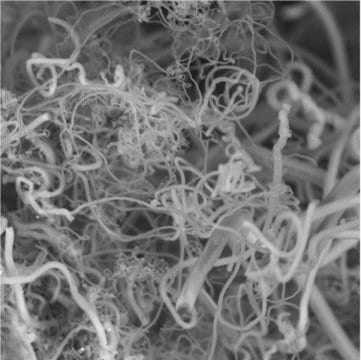
Credit: Stuart Licht, Ph.D.
Finding a technology to shift carbon dioxide, the most abundant anthropogenic greenhouse gas, from a climate change problem to a valuable commodity has long been a dream. Now, a team of chemists says they have developed a technology to economically convert atmospheric CO2 directly into highly valued carbon nanofibers for industrial and consumer products.
“We have found a way to use atmospheric CO2 to produce high-yield carbon nanofibers,” says Stuart Licht, Ph.D., who leads a research team at George Washington University. “Such nanofibers are used to make strong carbon composites, such as those used in the Boeing Dreamliner, as well as in high-end sports equipment, wind turbine blades and a host of other products.”
Previously, the researchers had made fertilizer and cement without emitting CO2 , which they reported. Now, the team, which includes postdoctoral fellow Jiawen Ren, Ph.D., and graduate student Jessica Stuart, says their research could shift CO2 from a global-warming problem to a feed stock for the manufacture of in-demand carbon nanofibers.
Licht calls his approach “diamonds from the sky.” That refers to carbon being the material that diamonds are made of, and also hints at the high value of the products, such as the carbon nanofibers that can be made from atmospheric carbon and oxygen.
Because of its efficiency, this low-energy process can be run using only a few volts of electricity, sunlight and a whole lot of carbon dioxide. At its root, the system uses electrolytic syntheses to make the nanofibers. CO2 is broken down in a high-temperature electrolytic bath of molten carbonates at 1,380 degrees F (750 degrees C). Atmospheric air is added to an electrolytic cell. Once there, the CO2 dissolves when subjected to the heat and direct current through electrodes of nickel and steel. The carbon nanofibers build up on the steel electrode, where they can be removed, Licht says.
To power the syntheses, heat and electricity are produced through a hybrid and extremely efficient concentrating solar-energy system. The system focuses the sun’s rays on a photovoltaic solar cell to generate electricity and on a second system to generate heat and thermal energy, which raises the temperature of the electrolytic cell.
Licht estimates electrical energy costs of this “solar thermal electrochemical process” to be around $1,000 per ton of carbon nanofiber product, which means the cost of running the system is hundreds of times less than the value of product output.
“We calculate that with a physical area less than 10 percent the size of the Sahara Desert, our process could remove enough CO2 to decrease atmospheric levels to those of the pre-industrial revolution within 10 years,” he says.
Read more: ‘Diamonds from the sky’ approach turns CO2 into valuable products
The Latest on: Carbon molten air battery
[google_news title=”” keyword=”carbon molten air battery” num_posts=”10″ blurb_length=”0″ show_thumb=”left”]
via Google News
The Latest on: Carbon molten air battery
- Reimagining energy: How former fossil fuel sites are driving the renewable revolutionon April 30, 2024 at 6:28 am
This shift can help us reduce carbon emissions ... Pumped hydro, compressed air, and emerging technologies like flow batteries are choices for long-duration storage. Thermal energy storage, which uses ...
- People in composites: April 2024on April 29, 2024 at 5:00 pm
supercharging growth opportunities in markets including aerospace and advanced air mobility [AAM], wind energy, battery, automotive and hydrogen.” Hodgson brings a wealth of experience to his new ...
- What is a 'sand battery'? And what does it mean?on April 28, 2024 at 9:05 pm
Permanent and modular lithium-ion battery systems are the most common way of storing surplus renewable energy. In fact, used electric vehicle batteries are increasingly finding a second service life ...
- Single-walled carbon nanotubes doped with 'nitrogen' enhance the performance of secondary battery anodeon April 24, 2024 at 9:27 am
Researchers have developed a new manufacturing technique for "silicon/nitrogen-doped carbon composite anode materials." These materials aim to enhance the capacity and stability of lithium-ion battery ...
- Batteries made of super-hot sand: for long-duration grid storage at $4 to $10 per kWhon April 24, 2024 at 12:00 am
Our electric future needs low-cost long-duration storage for grids. Per kWh, pumped hydropower is about $60, compressed air energy storage (CAES) costs from $150 to $300, and lithium-ion batteries ...
- Form Energy, other Mass. organizations get DOE funding for iron, steel productionon April 22, 2024 at 2:40 am
Several Massachusetts-based organizations working on zero-process-emission ironmaking and ultra-low life cycle emissions steelmaking got millions in federal funds.
- MIT Technology Reviewon April 18, 2024 at 3:00 am
Some thermal storage systems are soaking up waste heat rather than relying on electricity. Brenmiller Energy, for example, is building thermal batteries that can be charged up with heat or electricity ...
- Making the case for concentrated solar poweron April 17, 2024 at 7:35 am
Dismissed by many in the solar industry as an overly complex, outdated technology, concentrated solar power (CSP) is set for a comeback thanks to a scaled-down, modular approach.
- Shanghai Electric Lights Up 2024 World Future Energy Summit in Abu Dhabi with Its Zero-Carbon Solutionson April 17, 2024 at 7:13 am
Shanghai Electric Power Generation Group ("Shanghai Electric" or "the Company"), a key subsidiary of Shanghai Electric (SEHK:2727, SSE:601727) specializing in themanufacture of power generation ...
- Air Conditioning Has a Big Climate Impact. This New Technology Could be a Game Changeron April 16, 2024 at 12:54 pm
But with climate change, that is set to increase. Cooling is the fastest growing use of energy in buildings, with some estimates suggesting that energy demand for space cooling will more than triple ...
via Bing News










